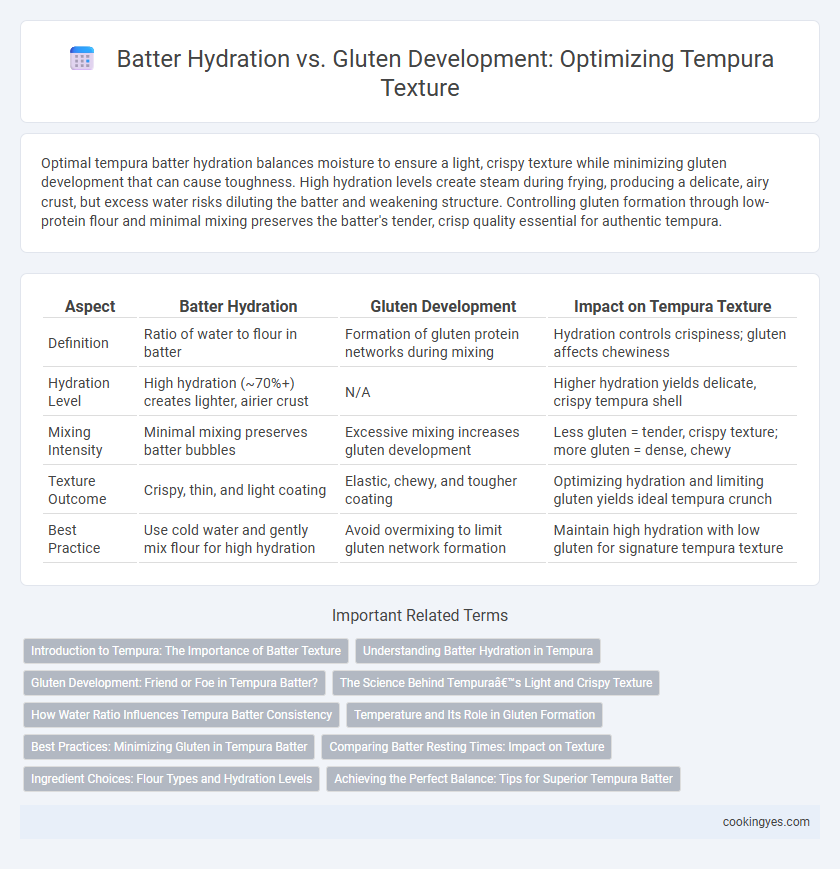Optimal tempura batter hydration balances moisture to ensure a light, crispy texture while minimizing gluten development that can cause toughness. High hydration levels create steam during frying, producing a delicate, airy crust, but excess water risks diluting the batter and weakening structure. Controlling gluten formation through low-protein flour and minimal mixing preserves the batter's tender, crisp quality essential for authentic tempura.
Table of Comparison
| Aspect | Batter Hydration | Gluten Development | Impact on Tempura Texture |
|---|---|---|---|
| Definition | Ratio of water to flour in batter | Formation of gluten protein networks during mixing | Hydration controls crispiness; gluten affects chewiness |
| Hydration Level | High hydration (~70%+) creates lighter, airier crust | N/A | Higher hydration yields delicate, crispy tempura shell |
| Mixing Intensity | Minimal mixing preserves batter bubbles | Excessive mixing increases gluten development | Less gluten = tender, crispy texture; more gluten = dense, chewy |
| Texture Outcome | Crispy, thin, and light coating | Elastic, chewy, and tougher coating | Optimizing hydration and limiting gluten yields ideal tempura crunch |
| Best Practice | Use cold water and gently mix flour for high hydration | Avoid overmixing to limit gluten network formation | Maintain high hydration with low gluten for signature tempura texture |
Introduction to Tempura: The Importance of Batter Texture
Tempura batter hydration plays a crucial role in achieving the trademark light and crispy texture, with higher water content inhibiting excessive gluten development. Limited gluten formation prevents toughness and promotes a delicate, airy crust that complements the ingredients inside. Balancing hydration and gluten development ensures the ideal tempura texture, highlighting the contrast between crisp exterior and tender interior.
Understanding Batter Hydration in Tempura
Batter hydration in tempura directly impacts the texture by balancing moisture and flour content to achieve a light, crispy coating. Higher hydration levels reduce gluten development, preventing toughness and ensuring a delicate, airy crunch. Precise control of water-to-flour ratio is essential for maintaining the signature tempura crispiness without excessive chewiness.
Gluten Development: Friend or Foe in Tempura Batter?
Gluten development in tempura batter directly impacts its texture, where minimal gluten formation creates the desired light and crispy coating. Overworking the batter increases gluten strands, resulting in a dense and chewy crust that defeats tempura's signature delicacy. Controlling hydration levels while gently mixing prevents excessive gluten development, balancing structure and tenderness for the perfect tempura bite.
The Science Behind Tempura’s Light and Crispy Texture
Tempura's light and crispy texture relies on optimal batter hydration, which limits gluten development to prevent toughness. High water content in the batter dilutes gluten-forming proteins in wheat flour, ensuring minimal elasticity and a delicate, airy crust upon frying. Controlling batter viscosity and temperature enhances this effect, creating the signature crispness without heaviness.
How Water Ratio Influences Tempura Batter Consistency
The water ratio in tempura batter critically affects hydration levels, which in turn control gluten development, essential for the ideal light and crispy texture. Higher water content results in a thinner batter that limits gluten formation, producing a delicate, airy coating that resists oil absorption. Conversely, lower water content promotes gluten network strength, yielding a denser, chewier crust unsuitable for authentic tempura.
Temperature and Its Role in Gluten Formation
Lower batter temperature slows gluten formation by restricting protein interaction, resulting in a lighter, crispier tempura texture. Cold water in the batter reduces gluten development, preventing chewiness and promoting delicate crispness. Maintaining a chilled batter between 10-15degC optimizes hydration without activating too much gluten, ensuring perfect tempura crunch.
Best Practices: Minimizing Gluten in Tempura Batter
High hydration in tempura batter is crucial to creating a light, crispy texture by limiting gluten development, which can cause toughness. Using ice-cold water and minimal mixing prevents gluten strands from forming, preserving the batter's delicate crispiness. Incorporating low-protein flours such as cake or rice flour further reduces gluten formation, ensuring an airy and brittle tempura coating.
Comparing Batter Resting Times: Impact on Texture
Optimal tempura batter hydration ranges around 1:1 water to flour ratio to balance crispiness and lightness, minimizing gluten development for tender texture. Resting the batter for 10-15 minutes allows moderate hydration without significant gluten formation, resulting in a delicately crisp crust ideal for tempura. Extended resting beyond 30 minutes promotes gluten development, causing a denser, chewier coating that diminishes the signature airy texture.
Ingredient Choices: Flour Types and Hydration Levels
Tempura batter achieves its signature light and crispy texture through careful balance between flour type and hydration levels. Low-protein flours like cake or pastry flour reduce gluten development, resulting in a tender, delicate crust, while higher hydration ratios create a thinner, crispier coating by minimizing gluten network formation. Optimal tempura batter typically uses cold water and a hydration level around 1:1 to limit gluten elasticity and enhance the airy, crunchy texture characteristic of authentic Japanese tempura.
Achieving the Perfect Balance: Tips for Superior Tempura Batter
Achieving the perfect tempura batter requires a precise balance between batter hydration and gluten development to ensure a light, crispy texture. High hydration ratios increase batter fluidity, promoting a thin, airy coating, while minimizing gluten formation prevents toughness and chewiness. Using ice-cold water and minimal mixing preserves starch integrity, resulting in superior tempura with optimal crispness and delicate crunch.
Batter hydration vs gluten development for tempura texture Infographic

 cookingyes.com
cookingyes.com